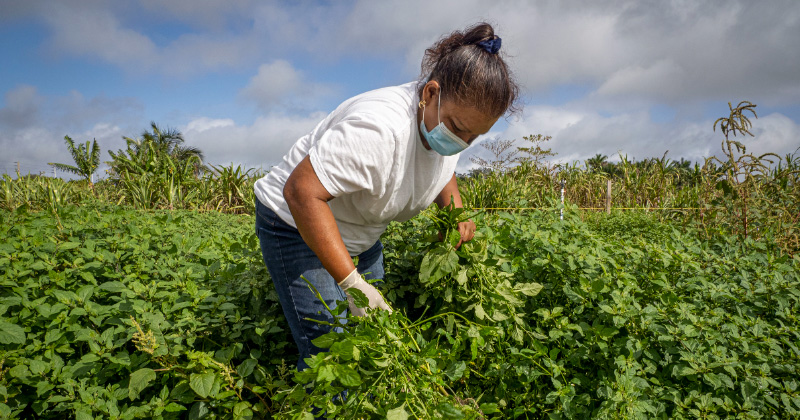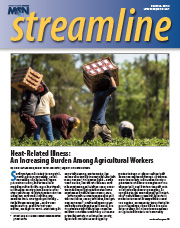
Work is a social determinant of health (SDOH; see sidebar on SDOHs). Many of the working conditions that resulted in greater risk for COVID-19 also increase the risk of or negatively affect other health concerns. The pandemic exposed those working conditions.When COVID-19 began to rip through the country in early 2020, it spread unevenly. In particular, food and agricultural workers were disproportionately affected. Food system workers, long overlooked and frequently exploited in the workplace, were suddenly deemed “essential,” requiring them to work through the pandemic despite the risk of disease. The poor working conditions that left them vulnerable to COVID-19 became front page news.
As of early August 2021, over 91,000 food and agricultural workers – in orchards, fields, meatpacking plants, poultry processing facilities, and more – have been sickened by COVID-19, and at least 465 have died.1 These numbers are likely a considerable undercount. Numerous barriers exist that prevent food system workers from accessing culturally competent health care for COVID-19 testing or treatment when needed. These same barriers reduce access to vaccines. Examples of access issues include: limited access to transportation; unfamiliarity with community resources and poor community integration, in the case of migrant workers; language and cultural barriers; and fear of exposing immigration status. Limited job data collection at sites of health provision has likely further reduced the accuracy of the count.
What is a Social Determinant of Health and how do clinicians address them?
SDOHs are external conditions that play a critical role in the health and well-being of a person, according to the Centers for Disease Control and Prevention (CDC).6 This includes the role that homes, neighborhoods, schools, and workplaces have on one’s health. SDOH is a popular framing in public health to discuss the backdrop of a person’s life that may influence their health and their ability to maintain their health.
With limited time in the exam room and limited resources, clinicians are often ill equipped to address SDOHs in their treatment plans for their patients, despite the significant impacts on health that they may pose. Health centers incorporating multidisciplinary care teams allow for a warm handoff of a patient to a nutrition specialist to access nutrition and food assistance programs. Meeting with a social worker to sign up for housing assistance and enrollment in other programs and social services can improve a patient’s health, reduce the overall cost of care for the health center, and allow clinicians to focus on clinical needs, knowing that the patient’s social needs are being addressed. For example, a patient experiencing pesticide poisoning that requires ongoing care in many cases is eligible for workers’ compensation, regardless of immigration status.7 The clinician, in addition to caring for the patient’s medical condition and reporting the pesticide exposure to state authorities, should provide referral to either a social worker, a medical-legal partnership worker, or other patient advocate who can help the patient understand his or her basic rights, learn how to access workers’ compensation benefits, and help the patient navigate referrals when needed.
None of these barriers to health and well-being are new. Work-related determinants of health have negatively affected agricultural workers for generations. Agricultural workers lack some of the basic protections that all other workers are afforded, including the right to organize, minimum wage, overtime, paid sick leave, and workers’ compensation, although state-level regulations may address some of these gaps in some states.234 This agricultural exceptionalism, which began in the 1930s with the Fair Labor Standards Act and other federal worker protections that excluded farmworkers and persists today, fortifies cycles of poverty and affects workers’ health.5 Without the right to organize, workers have little sway in wages, which remain at poverty level in many parts of the country. Agricultural workers may be unable to afford to take time off work to receive needed care. When working conditions are unsafe, workers often feel disenfranchised and unable to ask for changes to improve those conditions, which may further endanger their health.
As the pandemic wears on, the spotlight on agricultural worker health has dimmed. Yet, most of these work-related determinants of health still exist. However, agricultural workers may be in a better position than before the pandemic in some ways. In many areas of the country, the COVID-19 pandemic boosted the development of numerous partnerships, between health centers, farm owners, agricultural workers, growers’ associations, farmworker advocates, state officials, and others. These partnerships developed, often among former antagonists, because agricultural workers needed a safe workplace in order for our food systems to continue operating – a goal on which all partners could agree. These partnerships can continue and be strengthened after the pandemic, to continue to serve agricultural worker health needs.
Clinicians serving agricultural worker communities have a unique opportunity to increase outreach to those communities to build on trust and familiarity that arose from pandemic-related outreach, to grow and strengthen relationships with farm owners and others that were previously untenable, and to continue to increase awareness of agricultural worker health needs through communication with state leaders, growers’ associations, and other partners with a stake in food system efficiency. With greater communication and trust, these partners can more quickly respond to the next virus, wildfire, hurricane, or other unexpected disaster, to ensure that agricultural workers stay safe on the job, and our food systems remain intact during an emergency. They also will reduce the negative SDOHs that have plagued agricultural workers for decades, which can result in improved health and well-being for this too-often overlooked segment of the workforce.
Best Practices in Work-Related Social Determinants of Health
- Make sure the clinic is collecting work information, including asking if patients work in agriculture. Utilize MCN’s Environmental and Occupational Health Screening Questions for Primary Care: https://bit.ly/3vCBMPm. Use MCN’s algorithm for identification of migrant and seasonal agricultural workers, available in English and Spanish: https://bit.ly/3pYtsIq
- Provide low-literacy and culturally appropriate content on common work health risks. Offer MCN’s comic books, on pesticide exposure at work and home, dairy worker safety, and more: https://bit.ly/3iSAlJT
- Know how to report a pesticide exposure. Use this pesticide reporting map, which provides information for each state, developed by MCN in partnership with Farmworker Justice: https://bit.ly/3vtVlsL
- Provide warm handoffs to social workers or patient advocates who can assist with workers’ compensation and other know-your-rights concerns. Get resources on workers’ compensation related to health needs: https://www.migrantclinician.org/workerscomp
- Consider a medical-legal partnership within the clinic to assist with issues like workers’ compensation. Read about one health center’s medical-legal partnership: https://bit.ly/3pYX9ZI
- Build partnerships with local workplaces so that farm owners can turn to the clinic should health concerns arise. Learn about how outreach teams grew partnerships with workplaces during COVID-19: https://www.migrantclinician.org/best-practices-in-mobile-team-outreach
References:
1 Douglas L. Mapping Covid-19 outbreaks in the food system. Food and Environment Reporting Network. Accessed 5 August 2021. Available at: https://thefern.org/2020/04/mapping-covid-19-in-meat-and-food-processing-plants/
2 Liebman AK, Wiggins MF, Fraser C, Levin J, Sidebottom J, Arcury TA. Occupational health policy and immigrant workers in the agriculture, forestry, and fishing sector. Am J Ind Med. 2013;56(8):975-984. doi:10.1002/ajim.22190
3 Liebman AK, Augustave W. Agricultural health and safety: incorporating the worker perspective. J Agromedicine. 2010;15(3):192-199. doi:10.1080/1059924X.2010.486333
4 Fact Sheet #12: Agricultural Employers Under the Fair Labor Standards Act (FLSA). U.S. Department of Labor, Wage and Hour Division. Revised January 2020. Accessed 5 August 2021. Available at: https://www.dol.gov/sites/dolgov/files/WHD/legacy/files/whdfs12.pdf
5 Kelker K. When labor laws left farm workers behind – and vulnerable to abuse. PBS News Hour. 18 September 2016. Accessed 5 August 2021. Available at: https://www.pbs.org/newshour/nation/labor-laws-left-farm-workers-behind-vulnerable-abuse
6 Social Determinants of Health: Know What Affects Health. Centers for Disease Control and Prevention. Accessed 5 August 2021. Available at: https://www.cdc.gov/socialdeterminants/index.htm
7 Rhodes J. Court Upholds Workers’ Comp Judgment for Undocumented Worker. The Society for Human Resource Management. 23 June 2021. Accessed 5 August 2021. Available at: https://www.shrm.org/resourcesandtools/legal-and-compliance/employment-law/pages/court-report-workers-comp-judgment-for-undocumented-worker.aspx

Read this article in the Summer 2021 issue of Streamline here!
Sign up for our eNewsletter to receive bimonthly news from MCN, including announcements of the next Streamline.